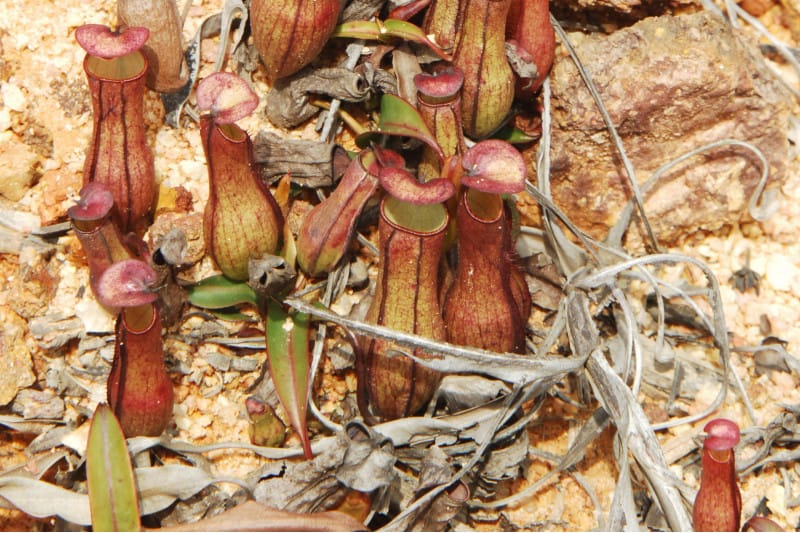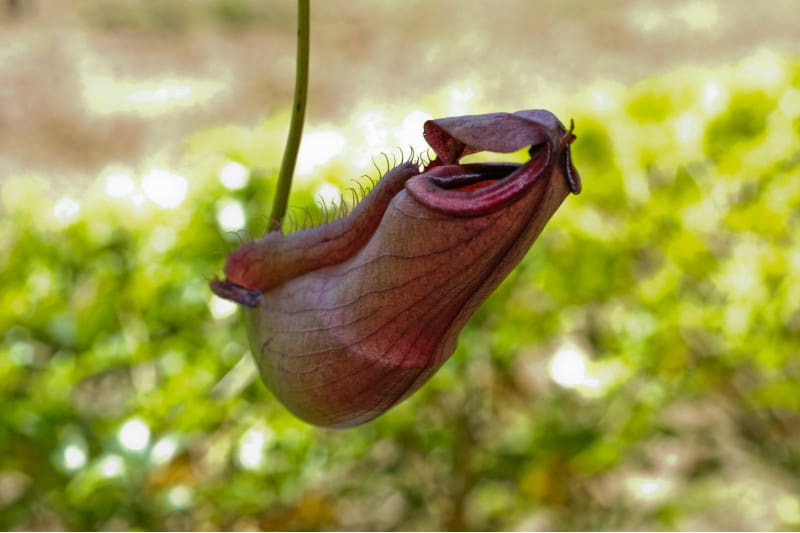No products in the cart.
Table of Contents
Okay, when you read about this plant, you too will want one for your home. Yes, the Nepenthes alata has some unique features you’ll find interesting. The plant is part of the carnivorous plants, also known as pitcher plants or monkey cups.
No, don’t leave yet it does not eat humans, only insects. Still, it is a fascinating tropical pitcher plant your guests will still be talking about for a long time.
What Are Tropical Pitcher Plants

You must agree this is one exciting species that will keep you amazed for a long time. What fascinates gardeners is the pitchers found in the middle part of the leaf. The containers look like cups. You see the monkeys occasionally drinking from them, resulting in the name monkey cups.
You find these plants growing in different environments, such as the Philippines highlands. The foliage belongs to the Nepenthaceae family and feeds on insects you find in your home. Raised as a houseplant provides loads of benefits for you and the pitcher plant.
The plant grows eight-inch green pitchers that are tinted red with speckles. While they have specific requests, you must not let that deter you, as housing the monkey cup is easy.
Tropical Pitcher Plant Care
The pitcher plants are climbing carnivorous plants comprising over 200 species. You find them growing like vines. You can grow them almost anywhere in the home, a terrarium or a greenhouse. You can find them in female plants and male plants, but the majority of them are male.
The fascinating thing is that pitcher plants have pitfall traps filled with digestive juice. These pitfalls form from the leaves and take months to mature. While the traps do not move, it is enormous to catch wasps, ants, and more. The plant lures these insects with its nectar.

Best Potting Soil For Tropical Pitcher Plants
The pitcher plant lives in poor environments where the soil is not high in nutrients. This is understandable as the plants feed on insects. So, it’s best to invest in a potting mix that is porous but low in nutrients.
You can include sphagnum moss, peat moss, orchid bark, and perlite in your mix. The water needs to drain well. You can use silica sand as well to keep the medium coarse. This type of structure helps the roots to access air without causing problems.
Necessary Lighting to Thrive
Your monkey cups plant favors high levels of light. A new plant needs a good amount of energy for the enzymes to attract insects. Even digesting insects requires loads of energy. Direct sunlight can leave the foliage scorched. To compromise, find a spot providing your pitcher plants with bright light but not direct sun.
For outdoor growing, a mix of sun and shade will keep your plant happy.
Watering Needs of Tropical Pitcher Plants
One thing we do not want is for your pitcher plant to dry out. The fascinating thing about the Nepenthes alata is that it is a mix of highland and lowland species. But most of the time, they prefer growing in the lowland alongside swamps.

The plant relies on water to flush out all the salts absorbed by ingesting insects. They do not mind having soggy roots but do not let them sit in water either as it can lead to root rot.
Your plant prefers overwatering but it also depends on a few factors. Consider if your home is hot. If so, increase the watering of your monkey cups plant. Another thing the pitcher plants are picky about is the water they receive. They need clean water, and tap water will not do.
So, we recommend giving your plant purified, distilled, or rainwater.
Temperature and Humidity Conditions
Your pitcher plant can handle high temperatures to an extent ranging from 53° F and above (12°C above). But take note that it may vary depending on certain factors as well as the variety you own. If grown outdoors, you will find that you need to bring them inside.
If your plant stands close to a window, never leave it standing at an open one, as cold drafts can lead to stunt growth and death.
Now, your plant enjoys high humidity but it can tolerate low humidity to some extent. So it’s best to provide them with a habitat of 60% humidity and above. You can grow them in a terrarium or a greenhouse. But if you do not have these, just increase the moisture level around them in the air.
You can find humidity tents made for these plants to improve the humidity levels.
How Often Should We Fertilize our Nepenthes

Now, you may be wondering what fertilizer should you feed your Nepenthes alata. While your houseplants work well with liquid solutions, this plant does not. A great alternative is pellet plant food. The problem with a water-soluble feed is that it adds more toxicity to the ground.
Using a fertilizer pellet is straightforward, and all you do is place a small amount into an open cup while actively hunting. You’ll notice the pitcher encourages insects, but you can use a liquid-based one on the leaves once a week if there is none.
Propagating Carnivorous Plants
As with any plant, you may want to make sure that you have more than one of the same species. The best way to achieve this is with propagation. You can reproduce the pitcher plant with division and stem cuttings. Both are simple, but the quickest is stem cutting.
The best part is you can do this any time of the year.
Stem Cuttings
- Start with an actively growing stem that has two leaves.
- Remove the bottom leaf and make an incision about four inches in length.
- Do this for a couple of stems.
- Take a pot with soil and freshly watered to plant the stems.
- Place the stems at a vertical angle.
- After about two months, you’ll notice new roots growing, but the pitchers only develop after six months.
- Now you can transfer your cuttings to hanging pots or a larger one.
USDA Growth Zone

If you live in the hardiness USDA zone 10 and above, you can grow your pitcher plant year-round outdoors. For example, you can grow it annually and place them in containers to grow inside your house.
Potting and Growth Pitcher Plants
Before we get to potting your pitcher plant, it helps us understand the plant’s growth rate. One thing to remember is that the monkey cups plant does not spread out, making them suitable as a houseplant. The longest part of the foliage is its roots which can spread out.
You may find in some species the root system growing up to 49 feet in length but mostly happens in outdoor settings. Your outdoor plant can also live from a few months to five years after the pitcher opens.
The best time to replant your pitcher plant is if the soil has broken down or it becomes infected and dries out. For broken-down ground, it will look mushy, and you can expect to transplant your foliage annually or even every other year. But when you do this, keep in mind the roots are not tough so take care.
Other Nepenthes Species
In the Nepenthes species, you can find different varieties of tropical pitcher plants, as seen here:
Nepenthes mirabilis
 The swamp pitcher plant is a herb species found in the tropical pitcher plant family. The foliage is a climber and has broad leaves with greenish cups.
The swamp pitcher plant is a herb species found in the tropical pitcher plant family. The foliage is a climber and has broad leaves with greenish cups.
Nepenthes gracilis Korth
 The pitcher plant can grow long and trailing when it does not have any vertical support. The pitches are leaves that trap small insects that need to find shelter from the rain. The cups can vary in color from maroon, green, red, or orange.
The pitcher plant can grow long and trailing when it does not have any vertical support. The pitches are leaves that trap small insects that need to find shelter from the rain. The cups can vary in color from maroon, green, red, or orange.
The stems have a reddish-purple angular form.
Nepenthes izumiae
 The plant comes from Sumatra in the Barisan range and produces purple-black pitchers. The cups are toothy and flared peristomes. The foliage makes for an excellent hybrid and is a strict highland grower needing cool nights to thrive.
The plant comes from Sumatra in the Barisan range and produces purple-black pitchers. The cups are toothy and flared peristomes. The foliage makes for an excellent hybrid and is a strict highland grower needing cool nights to thrive.
Nepenthes Alata Diseases & Pests
Okay, we can see you laughing. How can a plant that eats insects be pestered by them? When grown as an indoor plant, can also get bothered by pests. The problem is that these plants mainly eat insects that fly and do not crawl. So keep an eye on mealybugs, aphids, thrips, and spider mites that love to dine on the leaves.
You can use neem oil, certain sprays, and pesticides to get rid of them. Another concern is Rhizoctonia and Fusarium which are fungal diseases. Your plant can get this disease when your use fertilizer directly on the soil.
Other Problems:
- Yellowing leaves might seem like a trauma in the plant, but older pitcher plants tend to turn yellow. This is because too much light can cause this to happen.
- Leaves shifting to brown is also a sign of aging and is not something to worry about. But if you have a young plant, it might need more humidity. To solve this, you can place a plastic bag over your plant or mist it frequently.
- Curling and dying back is a sign that your plant might be standing in water too long. Next, you can transfer your plant to a new container with fresh soil.
- Dry pitchers without water at the bottom of the cup need a little more water added to the soil.
Frequently Asked Questions
The pitcher plant lives on insects such as flies, wasps, ants, and more that come too close to the cup. Once the nectar secretions attract them, they fall inside and get trapped. Enzymes digest the insect through the digestive fluid. As a result, they receive all the nutrients they need to survive.
Some Nepenthes plants are challenging to grow as they need specific environmental conditions. In contrast, others are pretty easygoing and not too hard to care for.
Once the pitchers open up, your plant can live for a couple of months up to five years.
You can find the pitcher plant sold at different nurseries or online. But the good news is you need not look far as Plantly has got you covered with Nepenthes alata.
Whether you want to buy, sell or simply reach out to other plant enthusiasts, Plantly is the right place to be!


